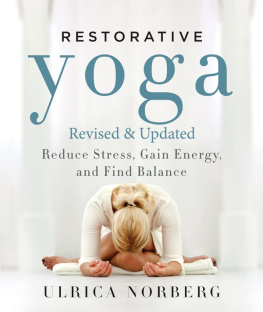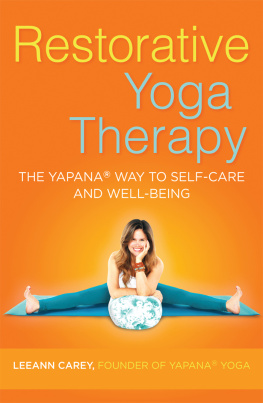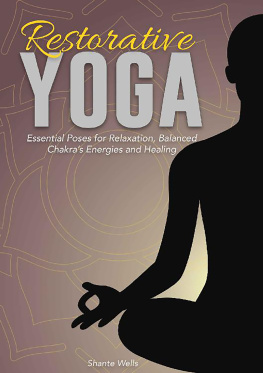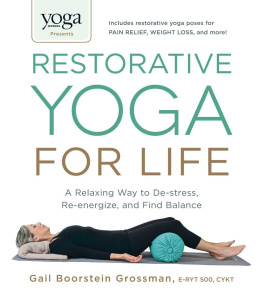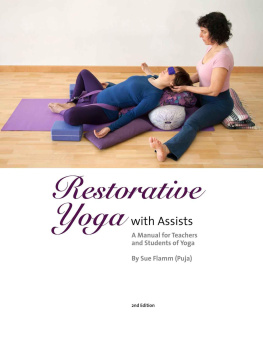Gail Parker - Restorative Yoga for Ethnic and Race-Based Stress and Trauma
Here you can read online Gail Parker - Restorative Yoga for Ethnic and Race-Based Stress and Trauma full text of the book (entire story) in english for free. Download pdf and epub, get meaning, cover and reviews about this ebook. year: 2020, publisher: Jessica Kingsley Publishers, genre: Religion. Description of the work, (preface) as well as reviews are available. Best literature library LitArk.com created for fans of good reading and offers a wide selection of genres:
Romance novel
Science fiction
Adventure
Detective
Science
History
Home and family
Prose
Art
Politics
Computer
Non-fiction
Religion
Business
Children
Humor
Choose a favorite category and find really read worthwhile books. Enjoy immersion in the world of imagination, feel the emotions of the characters or learn something new for yourself, make an fascinating discovery.
- Book:Restorative Yoga for Ethnic and Race-Based Stress and Trauma
- Author:
- Publisher:Jessica Kingsley Publishers
- Genre:
- Year:2020
- Rating:5 / 5
- Favourites:Add to favourites
- Your mark:
- 100
- 1
- 2
- 3
- 4
- 5
Restorative Yoga for Ethnic and Race-Based Stress and Trauma: summary, description and annotation
We offer to read an annotation, description, summary or preface (depends on what the author of the book "Restorative Yoga for Ethnic and Race-Based Stress and Trauma" wrote himself). If you haven't found the necessary information about the book — write in the comments, we will try to find it.
Gail Parker: author's other books
Who wrote Restorative Yoga for Ethnic and Race-Based Stress and Trauma? Find out the surname, the name of the author of the book and a list of all author's works by series.
Restorative Yoga for Ethnic and Race-Based Stress and Trauma — read online for free the complete book (whole text) full work
Below is the text of the book, divided by pages. System saving the place of the last page read, allows you to conveniently read the book "Restorative Yoga for Ethnic and Race-Based Stress and Trauma" online for free, without having to search again every time where you left off. Put a bookmark, and you can go to the page where you finished reading at any time.
Font size:
Interval:
Bookmark:

RESTORATIVE YOGA
FOR ETHNIC AND
RACE-BASED STRESS
AND TRAUMA
GAIL PARKER, P H .D.
F OREWORDS BY OCTAVIA F. RAHEEM
AND AMY WHEELER, P H .D.
I LLUS TRATED BY JUSTINE ROSS

O CTAVIA F. R AHEEM
I WILL never forget when I first met Dr. Gail Parker. I noticed something. Her shoulders were relaxed and down. Wholeness, a kind of ease, even grace radiated from the center of her chest. I was struck by the lift in her heart. I was a yoga teacher and in my early 30s, yet I had rarely encountered a woman who moved with such lightness emanating from her heart.
Earlier that same year my mother had survived a type of heart attack that her surgeon said many people do not. Of course, there are many factors, some would call them lifestyle, yet who can tally the impact of decades of race-based stress and trauma on my mothers heart? How long had she been under pressure? Did it start the day she was born, or in her mothers womb? What really attacked her heart? Whos counting the additional weight of each negative race-based experience? Could the sum of it lead to a broken heart that fights against itself?
I met Dr. Parker at the Yoga Retreat for Women of Color led by Maya Breuer in 2012. We randomly partnered for an exercise that required us to sit face to face, knee to knee, heart to heart, and speak our truth. From the moment I sat in front of Gail, I felt seen. Even before I opened my mouth, I knew she heard more than I could ever say. I learned later that she was a psychotherapist, meditation and Restorative Yoga teacher, and mother. I am sure the knowledge, skill, and wisdom shes earned in those roles greatly contribute to her capacity to be so present. I also believe there is something else, a subtler quality and energy that I experienced in that moment: The compassion and permission that are wordlessly granted when we are in the presence of someone whose heart has been broken by the world, yet theyve been able to recover their wholeness.
I once read that when Dr. King was examined post death, he was found to have the heart of a 65-year-old. He was only 39. To say his heart was heavy and weary is an understatement. To say it was weighted is to misstate the magnitude of the load. It doesnt diminish his legacy or his battle for human and civil rights for all, if we, for this singular moment, ponder the impact only race had on the sustained wear and tear within his heart. Who can calculate the ways that the stress and trauma of racism clog ones arteries, creating blockages and inhibiting access to deeper inner movement?
In 2016 I had the opportunity to formally study Restorative Yoga in a teacher training format led by Dr. Parker. Having studied Restorative Yoga in many different capacities, I was delighted to continue my learning with Gail. The first night of training we discussed stress responses. Previous restorative trainings I had attended only examined the fight-or-flight response. Gail included another response, tend and befriend, a uniquely feminine response to stress first proposed by Shelley E. Taylor. That inclusion of what is often left out of Restorative Yoga trainings initial overview of the stress response was a prelude to the way Dr. Parker taught Restorative Yoga and trained teachers: As only a woman with 50+ years of experience as a psychologist, researcher, community leader, in addition to yoga educator/therapist could.
Over the course of that first Restorative Yoga teacher training with Gail she addressed something else Id never heard acknowledged in all of my years of being a student and teacher of yoga race-based trauma and stress . Within her naming of this, I found affirmation of so much of my experience as an African American woman in the world. She offered the perspective that teachers of yoga need to first be aware of this stress and impact within self in order to be more aware of it within our students. That training was the first time I realized that I could more deliberately use Restorative Yoga as a tool to support me in some of my biggest areas of challenge and ongoing stressthose due to race. I knew that this work and the lens through which Dr. Parker offered it could radically change an individuals relationship to self. The trajectory of my work as a yoga teacher shifted. Later that year I opened a yoga studio, Sacred Chill {West}, and decided to focus on Restorative Yoga and yoga styles that are more easeful in naturemeditation and Yoga Nidra.
Sometimes I lay my head against my husbands chest and listen to the life story it taps out. Sometimes it drums rapidly and full of strained whispers, running, running, running. I wonder what memory, experience, or recent encounter in his skin is calling out through his elevated pulse when I hear that frantic banging from the door of his heart?
In 2017, I had the opportunity to be a yoga student in Dr. Parkers immersionRestorative Yoga for Resilience: Bouncing Back from Race-Based Trauma and Stress for People of Color, in Atlanta, Georgia. Individuals traveled from as far as Boston and the Bahamas to attend. The room was full of yoga teachers, maternal and mental health specialists, professors, public and private educators, corporate executivesa wide range of individuals whod heard about Gails work and needed to experience it for themselves. The immersion wasnt about learning how to teach Restorative Yoga; it was about using it to intentionally cultivate a tool for self-care and to manage the stress and trauma that arise from the daily lived experiences as a person of color.
In that immersion I finally had the space and courage to fully recall sitting in my 9th-grade class in front of a young White man who thought it was funny to tap me on the head and call me the n word whenever the teacher wasnt looking. I remembered how I chose silence and not speaking up for myself (for weeks) because I feared no one would believe me if I told them what was happening. I remembered deciding Id had enough and leaving the class with no explanation. I went straight to my counselor and told her what was happening and how it made me feel unsafe and distracted me from learning. My counselor asked me if I was sure that what he was saying was the n word I did say it was a whisper, didnt I? I remembered how nothing happened to the young man. Despite the sinking feeling that I felt in that classroom and school from that point forward, I went through the rest of that school year convincing myself I didnt hear what I heard or feel what I felt. That I must have made it all up.
In her immersion, Gail asked me where I felt that experience in my body when I shared the story. My chest tightened. My breath became shallow. I felt exactly the place in my heart that had been broken from that 9th-grade encounter. In that immersion we didnt only tell our stories without the threat of penalty or recourse, which in and of itself was sacred elixir; we applied the balm of Restorative Yoga. We were held in supported postures. We were invited to rest and feel. Rest and release. Rest and allow. Rest and know that we didnt cause the wound, yet it exists. By the end of that immersive experience and being held in such deep truth, community, and compassion, that place of separation and pain in my heart was indeed the place that light had entered. I left knowing a way to be more whole.
I recently asked my three-year-old son where his heart was and he touched my chest and said, In there, and then he touched his own chest, and said, Here too, Mama. He smiled.
Font size:
Interval:
Bookmark:
Similar books «Restorative Yoga for Ethnic and Race-Based Stress and Trauma»
Look at similar books to Restorative Yoga for Ethnic and Race-Based Stress and Trauma. We have selected literature similar in name and meaning in the hope of providing readers with more options to find new, interesting, not yet read works.
Discussion, reviews of the book Restorative Yoga for Ethnic and Race-Based Stress and Trauma and just readers' own opinions. Leave your comments, write what you think about the work, its meaning or the main characters. Specify what exactly you liked and what you didn't like, and why you think so.


